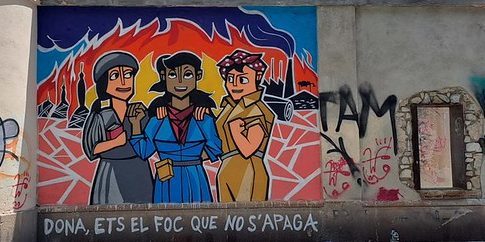The grafitti “Dona, ets foc que no s’apaga” (“Woman, you are a fire that never goes out”) stands as a vibrant tribute to the struggle and resilience of women throughout history on the external walls of the former prison La Model since May 21. The work was created as part of the fourth edition of the Rap for Memories project, an initiative driven by EUROM and the Barcelona City Council, in collaboration with Versembrant and the Escola d’Art La Industrial. This project aims to connect new generations with history through urban art and rap, thus fostering historical memory and critical reflection.
Artist Levico, in collaboration with Versembrant, has brought to life the ideas of students from the discipline of Gender Studies in this mural. The work is not only a visual artwork but also a manifesto that honors three women who have stood out at different moments in the history of feminism.
The first of these women is Maria Soliña, a Galician landowner and fisherwoman who was tortured by the Inquisition in 1621. Her story exemplifies the brutality faced by strong, independent women in the past. The second is María Pérez Lacruz, known as La Jabalina, the last woman executed by the Franco regime in 1942, symbolizing repression and the relentless fight for freedom during dark times. Finally, the mural pays homage to Casilda Hernández, an anarchist militiawoman of Romani descent who authored the phrase that gives the mural its title, “Dona, ets foc que no s’apaga,” encapsulating the unquenchable flame of female resistance and empowerment.
In addition to these historical figures, the mural features the iconic image created by Howard Miller in 1943 for Westinghouse Electric, popularly known as Rosie the Riveter. This illustration has become a universal symbol of women’s struggle for equal rights, representing the strength and determination of working women during World War II.
Levico’s drawing also pays tribute to the graphic artist Cristina Durán. Throughout her collaboraiton with Miguel Ángel Giner Bou, she is responsible of reviving one of the many silenced stories of women who fought for peace and freedom, echoing the deepest desire of La Jabalina’s mother: that such a great injustice never be forgotten.
Located on the exterior wall of the former La Model prison at Rosselló street, the graffiti invites reflection on past injustices and the ongoing fight for gender equality. Levico’s work, with its distinctive style and commitment to social justice, serves as a powerful reminder that the struggle for women’s rights remains as relevant today as it was in the past.
As in previous editions, the project rap for Memories Rap for Memories also includes three hip hop and rap tracks developed in collaboration with musician Bittah. These tracks are an integral part of the initiative, providing a dynamic medium for students to express their thoughts, feelings, and reflections on the themes of gender studies and historical memory explored throughout the course.
The tracks will soon be featured in an upcoming audiovisual document that aims to capture the essence of the students’ journey during the 2023-2024 academic year. This document will weave together footage of the mural creation process, interviews with students, and performances of the tracks, offering a comprehensive view of the educational and creative efforts that took place within the project. Through this multimedia approach, the project seeks to amplify the voices of the students, showcasing their engagement with history, art, and social justice, and highlighting the impact of these experiences on their understanding and perspective.
Pictures of the project on Flickr (click to see more)
Related project


